- IT governance is the number-one predictor of value generated by IT, yet many organizations struggle to organize their governance effectively.
- Current IT governance does not address the changing goals, risks, or context of the organization, so IT spend is not easily linked to value.
- The right people are not making the right decisions about IT.
Our Advice
Critical Insight
- Organizations do not have a governance framework in place that optimally aligns IT with the business objectives and direction.
- Implementing IT governance requires the involvement of key business stakeholders who do not see IT’s value in corporate governance and strategy.
- The current governance processes are poorly designed, making the time to decisions too long and driving non-compliance.
Impact and Result
- Use Info-Tech’s four-step process to optimize your IT governance framework.
- Our client-tested methodology supports the enablement of IT-business alignment, decreases decision-making cycle times, and increases IT’s transparency and effectiveness in decisions around benefits realization, risks, and resources.
- Successful completion of the IT governance redesign will result in the following outcomes:
- Align IT with the business context.
- Assess the current governance framework.
- Redesign the governance framework.
- Implement governance redesign.
Member Testimonials
After each Info-Tech experience, we ask our members to quantify the real-time savings, monetary impact, and project improvements our research helped them achieve. See our top member experiences for this blueprint and what our clients have to say.
9.3/10
Overall Impact
$205,494
Average $ Saved
32
Average Days Saved
Client
Experience
Impact
$ Saved
Days Saved
University of Northern British Columbia
Guided Implementation
10/10
$6,000
10
St Vrain Valley School District
Workshop
8/10
$9,099
18
The President and Fellows of Harvard College, a Massachusetts nonprofit corporation, acting by and through Harvard Business School
Guided Implementation
10/10
$32,499
20
City of Santa Fe
Workshop
10/10
$1.3M
120
City of Lakeland
Workshop
10/10
$64,999
50
Georgia Institute of Technology
Workshop
9/10
$1.3M
50
Canada Border Services Agency
Workshop
9/10
$14,500
10
Avalon Health Care Management Inc.
Workshop
8/10
$12,999
5
The University of North Carolina System Office
Guided Implementation
10/10
$12,999
20
Richland School District 400
Guided Implementation
10/10
$2,599
5
Arkansas Department of Transportation
Workshop
10/10
$1.3M
120
American Traffic Safety Services Association
Guided Implementation
10/10
$12,599
10
Canada Border Services Agency
Guided Implementation
8/10
$1,000
1
Ampath
Guided Implementation
10/10
N/A
N/A
Monroe #1 BOCES
Guided Implementation
10/10
$31,499
35
Richard Bland College
Guided Implementation
10/10
$31,499
20
Canada Border Services Agency
Guided Implementation
9/10
$10,000
10
Inmarsat Solutions Canada
Guided Implementation
8/10
N/A
10
Belmond
Guided Implementation
9/10
$10,000
10
Walter Reed National Military Medical Center
Workshop
9/10
$62,999
5
Crawford & Company
Workshop
8/10
$12,599
20
Choice Properties Limited Partnership
Guided Implementation
10/10
$50,000
50
Ora, Inc.
Guided Implementation
8/10
N/A
5
Central University of Technology
Guided Implementation
10/10
$2,479
110
State of Hawaii – ETS
Guided Implementation
10/10
$629K
60
Fiven
Guided Implementation
9/10
N/A
5
Federated Co-operatives Limited
Guided Implementation
9/10
$10,000
10
Omaha Public Power District
Workshop
10/10
$92,999
50
STgenetics
Guided Implementation
9/10
$123K
90
MTA Metropolitan Transportation Authority
Guided Implementation
10/10
N/A
2

IT Governance
Drive business value and enable effective decision making by optimizing IT governance structure and processes.
This course makes up part of the Strategy & Governance Certificate.
- Course Modules: 5
- Estimated Completion Time: 2-2.5 hours
- Featured Analysts:
- Valence Howden, Research Director and Executive Advisor, CIO Practice
- Gord Harrison, SVP Research
Workshop: Improve IT Governance to Drive Business Results
Workshops offer an easy way to accelerate your project. If you are unable to do the project yourself, and a Guided Implementation isn't enough, we offer low-cost delivery of our project workshops. We take you through every phase of your project and ensure that you have a roadmap in place to complete your project successfully.
Module 1: Identify the Need for Governance
The Purpose
Identify the need for governance in your organization and engage the leadership team in the redesign process.
Key Benefits Achieved
Establish an engagement standard for the leadership of your organization in the IT governance redesign.
Activities
Outputs
Identify stakeholders.
- Stakeholder Power Map
Make the case for improved IT governance.
- Make the Case Presentation
Customize communication plan.
- Communication Plan
Module 2: Align IT With the Business Context
The Purpose
Create a mutual understanding with the business leaders of the current state of the organization and the state of business it is moving towards.
Key Benefits Achieved
The understanding of the business context will provide an aligned foundation on which to redesign the IT governance framework.
Activities
Outputs
Review documents.
Analyze frameworks.
- PESTLE Analysis
- SWOT Analysis
Conduct brainstorming.
Finalize the Statement of Business Context.
- Statement of Business Context
Module 3: Assess the Current Governance Framework
The Purpose
Establish a baseline of the current governance framework.
Key Benefits Achieved
Develop guidelines based off results from the current state that will guide the future state design.
Activities
Outputs
Create committee profiles.
Build governance structure map.
- Current State Assessment
Establish governance guidelines.
Module 4: Redesign the Governance Framework
The Purpose
Redesign the governance structure and the committees that operate within it.
Key Benefits Achieved
Build a future state of governance where the relationships and processes that are built drive optimal business results.
Activities
Outputs
Build governance structure map.
- Future State Design
Create committee profiles.
- IT Governance Terms of Reference
Module 5: Implement Governance Redesign
The Purpose
Build a roadmap for implementing the governance redesign.
Key Benefits Achieved
Create a transparent and relationship-oriented implementation strategy that will pave the way for a successful redesign implementation.
Activities
Outputs
Identify next steps for the redesign.
- Implementation Plan
Establish communication plan.
Lead executive presentation.
- Executive Presentation
Improve IT Governance to Drive Business Results
Avoid bureaucracy and achieve alignment with a minimalist approach.
ANALYST PERSPECTIVE
Governance optimization is achieved where decision making, authority, and context meet.
"Governance is something that is done externally to IT and well as internally by IT, with the intention of providing oversight to direct the organization to meet goals and keep things on target.
Optimizing IT governance is the most effective way to consistently direct IT spend to areas that provide the most value in producing or supporting business outcomes, yet it is rarely done well.
IT governance is more than just identifying where decisions are made and who has the authority to make them – it must also provide the context and criteria under which decisions are made in order to truly provide business value" (Valence Howden, Director, CIO Practice Info-Tech Research Group)
Our understanding of the problem
This Research is Designed For:
- CIOs
- CTOs
- IT Directors
This Research Will Help You:
- Achieve and maintain executive and business support for optimizing IT governance.
- Optimize your governance structure.
- Build high-level governance processes.
- Build governance committee charters and set accountability for decision making.
- Plan the transition to the optimized governance structure and processes.
This Research Will Also Assist:
- Executive Leadership
- IT Managers
- IT Customers
- Project Managers
This Research Will Help Them:
- Improve alignment between business decisions and IT initiatives.
- Establish a mechanism to validate, redirect, and reprioritize IT initiatives.
- Realize greater value from more effective decision making.
- Receive a better overall quality of service.
Executive Summary
Situation
- IT governance is the #1 predictor of value generated by IT, yet many organizations struggle to organize their governance effectively.*
- Current IT governance does not address the changing goals, risks, or context of the organization so IT spend is not easily linked to value.
- The right people are not making the right decisions about IT.
Complication
- Organizations do not have a governance framework in place that optimally aligns IT with the business objectives and direction.
- Implementing IT governance requires the involvement of key business stakeholders who do not see IT’s value in governance and strategy.
- The current governance processes are poorly designed, creating long decision-making cycles and driving non-compliance with regulation.
Resolution
- Use Info-Tech’s four-step process for optimizing your IT governance framework. Our client-tested methodology supports the enablement of IT-business alignment, decreases decision-making cycle times, and increases IT’s transparency and effectiveness in making decisions around benefits realization, risks, and resources.
- Successful completion of the IT governance redesign will result in the following outcomes:
- Align IT with the business context.
- Assess the current governance framework.
- Redesign the governance framework.
- Implement governance redesign.
Info-Tech Insight
- Establish IT-business fusion. In governance, alignment is not enough. Merge IT and the business through governance to ensure business success.
- With great governance comes great responsibility. Involve relevant business leaders, who will be impacted by IT outcomes, to take on governing responsibility of IT.
- Let IT manage and the business govern. IT governance should be a component of enterprise governance, allowing IT leaders to focus on managing.
IT governance is...
An enabling framework for decision-making context and accountabilities for related processes.
A means of ensuring business-IT collaboration, leading to increased consistency and transparency in decision making and prioritization of initiatives.
A critical component of ensuring delivery of business value from IT spend and driving high satisfaction with IT.
IT governance is not...
An annoying, finger-waving roadblock in the way of getting things done.
Limited to making decisions about technology.
Designed tacitly; it is purposeful, with business objectives in mind.
A one-time project; you must review and revalidate the efficiency.
Avoid common misconceptions of IT governance
Don’t blur the lines between governance and management; each has a unique role to play. Confusing these results in wasted time and confusion around ownership.
Governance |
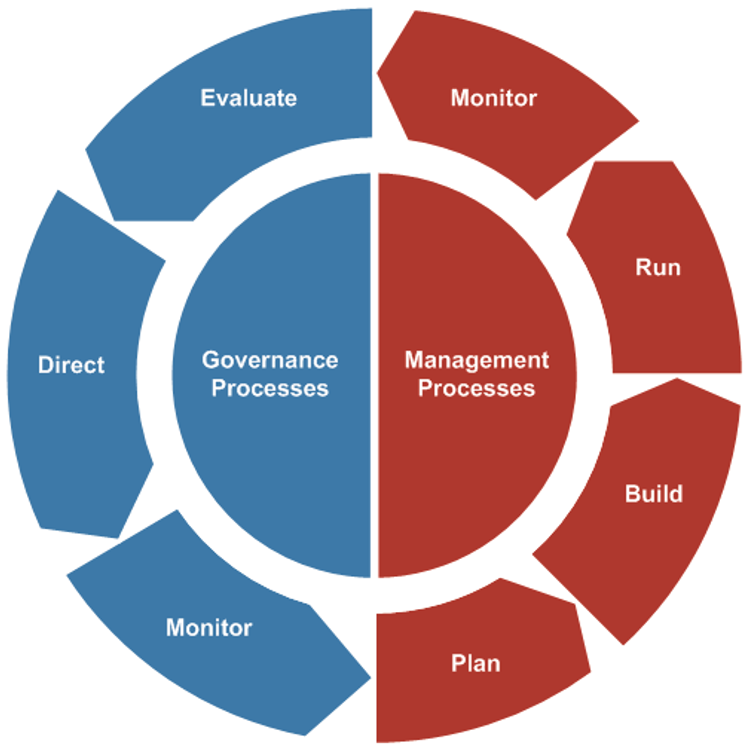 |
Management |
IT governance sets direction through prioritization and decision making, and monitors overall IT performance. Governance aligns with the mission and vision of the organization to guide IT. |
Management is responsible for executing on, operating, and monitoring activities as determined by IT governance. Management makes decisions for implementing based on governance direction. |
The IT Governance Framework
An IT governance framework is a system that will design structures, processes, authority definitions, and membership assignments that lead IT toward optimal results for the business.
Governance is performed in three ways:
Evaluate
Governance ensures that business goals are achieved by evaluating stakeholder needs, criteria, metrics, portfolio, risk, and definition of value.Direct
Governance sets the direction of IT by delegating priorities and determining the decisions that will guide the IT organization.Monitor
Governance establishes a framework to monitor performance, compliance to regulation, and progress on expected outcomes.
"Everyone needs good IT, but no one wants to talk about it. Most CFOs would rather spend time with their in-laws than in an IT steering-committee meeting. But companies with good governance consistently outperform companies with bad. Which group do you want to be in?" (Martha Heller, President, Heller Search Associates)
Create impactful IT governance by embedding it within enterprise governance
The business should engage in IT governance and IT should influence the direction of the business.
Enterprise Governance |
IT Governance |
|
Authority for enterprise governance falls to the board and executive management. Responsibilities Include:
|
–› Engage in –› ‹– Influence ‹– |
Governance of IT is a component of enterprise governance. Responsibilities Include:
|
Identify signals of sub-optimal IT governance within any of these domains
If you notice any of these signals, governance redesign is right for you!
Inability to Realize Benefits
- IT is unable to articulate the value of its initiatives or spend.
- IT is regularly delegated unplanned projects.
- The is no standard approach to prioritization.
- Projects do not meet target metrics.
Resource Misallocation
- Resources are wasted due to duplication or overlap in IT initiatives.
- IT projects fail at an unacceptable rate, leading to wasted resources.
- IT’s costs continue to increase without reciprocal performance increase.
Misdiagnosed Risks
- Risk appetite is incorrectly identified or not identified at all.
- Disagreement on the approach to risk in the organization.
- Increasing rate of IT incidents related to risk.
- IT is failing to meet regulatory requirements.
Dissatisfied Stakeholders
- There are no ways to measure stakeholder satisfaction with IT.
- Business strategies and IT strategies are misaligned.
- IT’s relationship with key stakeholders is unstable and there is a lack of mutual trust.
A majority of organizations experience significant alignment gaps
The majority of organizations and their key stakeholders experience highly visible gaps in the alignment of IT investments and organizational goals.
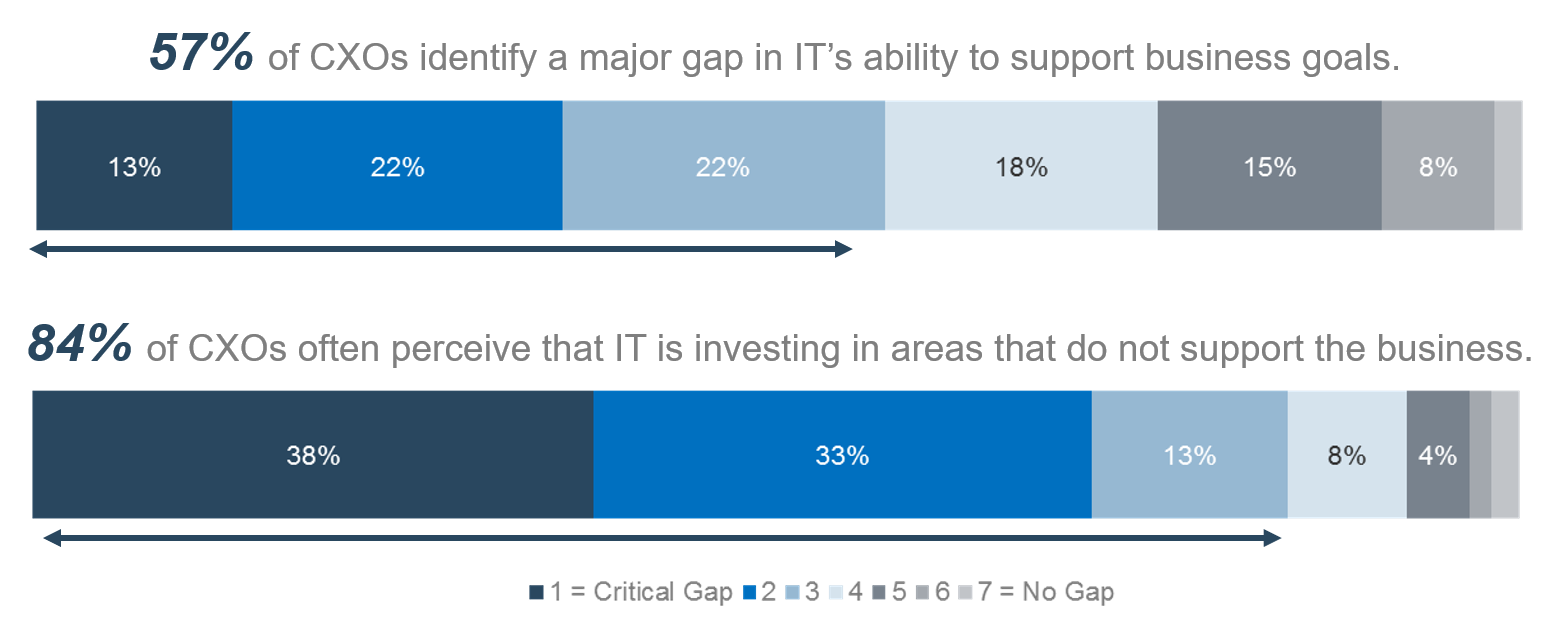
88% of CIOs believe that their governance is not effective. (Info-Tech Diagnostics)
Leverage governance as the catalyst for connecting IT and the business
49% of firms are misaligned on current performance expectations for IT.
- 49% Misaligned
- 51% Aligned
67% of firms are misaligned on the target role for IT.
- 34% Highly Misaligned
- 33% Somewhat Misaligned
- 33% Aligned
A well-designed IT governance framework will hep you to:
- Make sure IT keeps up with the evolving business context.
- Align IT with the mission and the vision of the organization.
- Optimize the speed and quality of decision making.
- Meet regulatory and compliance needs in the external environment. (Info-Tech Diagnostics)
Align with business goals through governance to attain business-IT fusion
Create a state of business-IT fusion, in which the two become one.
Without business-IT fusion, IT will go in a different direction, leading to a divergence of purpose and outcomes. IT can transform into a fused partner of the business by ensuring that they govern toward the same goal.
Firefighter
|
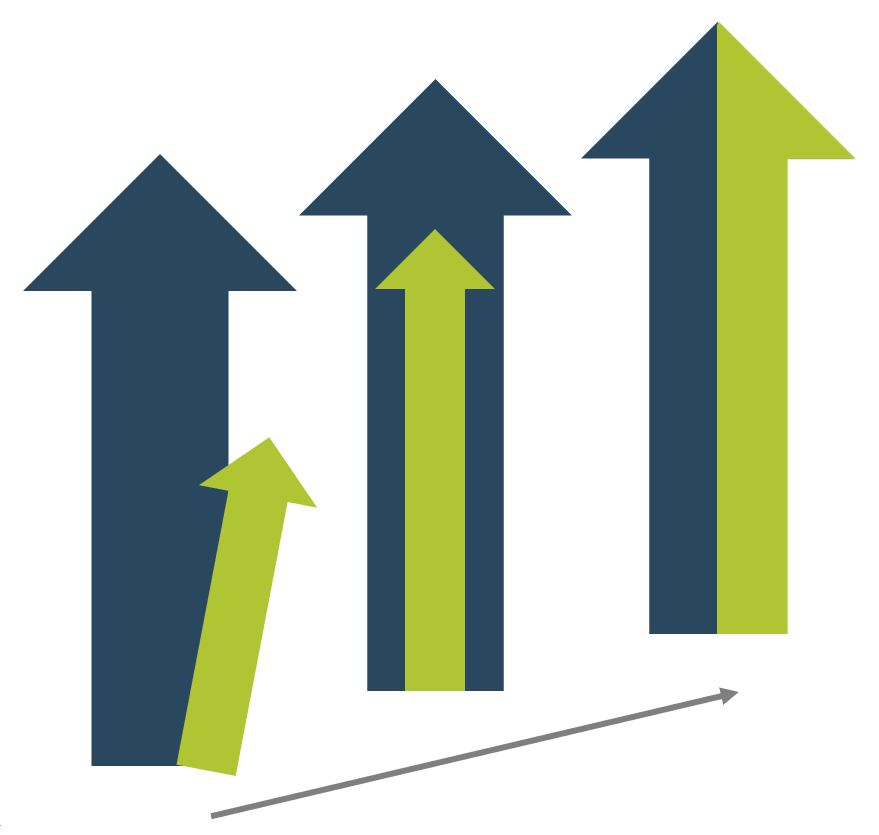 |
Business Partner
|
Redesign IT governance in accordance with COBIT and proven good practice
Info-Tech’s approach to governance redesign is rooted in COBIT, the world-class and open-source IT governance standard.
COBIT begins with governance, EDM – Evaluate, Direct, and Monitor.
We build upon these standards with industry best practices and add a practical approach based on member feedback.
This blueprint will help you optimize your governance framework.
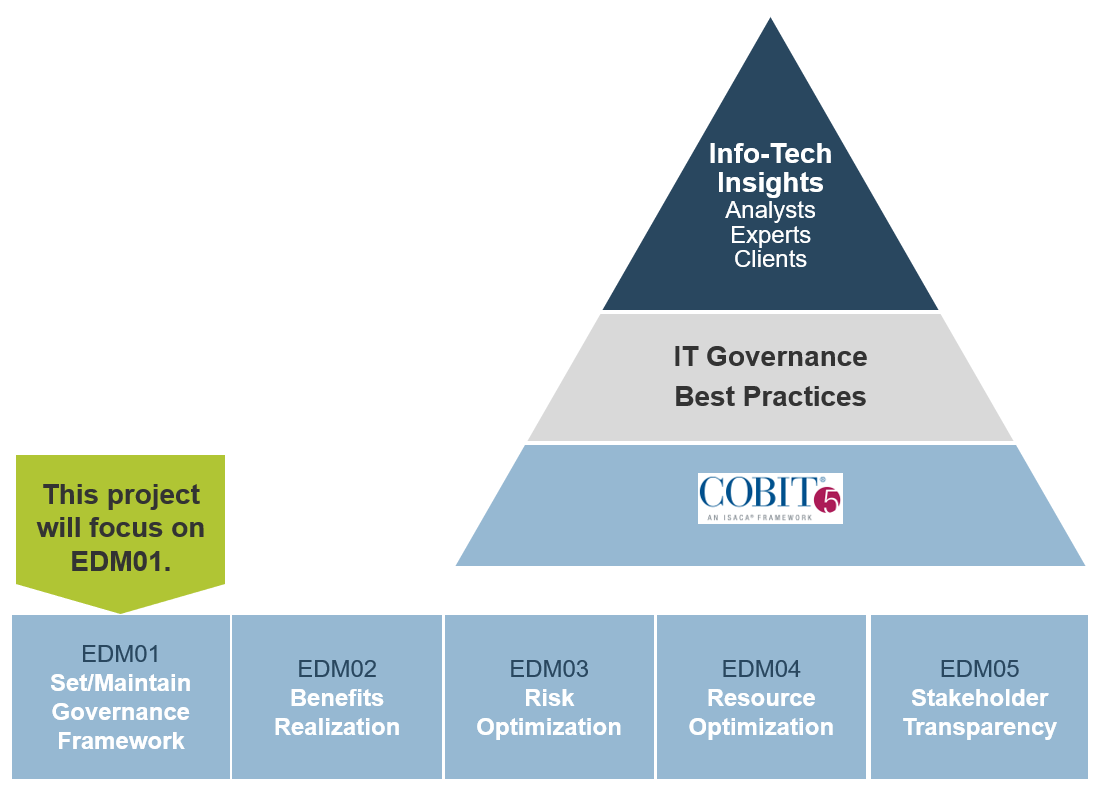
Use Info-Tech’s approach to implementing an IT governance redesign
The four phases of Info-Tech’s governance redesign methodology will help you drive greater value for the business.
- Align IT With the Business Context
Align IT’s direction with the business using the Statement of Business Context Template. - Assess the Current Governance Framework
Evaluate the strengths and weaknesses of current governance using the Current State Assessment of IT Governance. - Redesign the Governance Framework
Build a redesign of the governance framework using the Future State Design for IT Governance tool. - Implement Governance Redesign
Create an IT Governance Implementation Plan to jumpstart the communication of the redesign and set it up for success.
Continuously assess your governance framework to ensure alignment.
Leverage Info-Tech’s insights for an optimal redesign process
Common Pitfalls |
Info-Tech Solutions |
||
Phase 1 |
There must be an active understanding of the current and future state of the business for governance to address the changing needs of the business. | –› |
|
Phase 2 |
Take a proactive approach to revising your governance framework. Understand why you are making decisions before actually making them. | –› |
|
Phase 3 |
Keep the current and future goals in sight to build an optimized governance framework that maintains the minimum bar of oversight required. | –› |
|
Phase 4 |
Don’t overlook the politics and culture of your organization in redesigning your governance framework. | –› |
|
Leverage both COBIT and Info-Tech-defined metrics to evaluate the success of your redesign
These metrics will help you determine the extent to which your governance is supporting your business goals, and whether the governance in place promotes business-IT fusion.
Benefits Realization
- Percent of IT-enabled investments where benefit realization is monitored through the full economic life. (COBIT-defined metric)
- Percent of enterprise strategic goals and requirements supported by IT strategic goals. (COBIT-defined metric)
- Percent of IT services where expected benefits are realized or exceeded. (COBIT-defined metric)
Resources
- Satisfaction level of business and IT executives with IT-related costs and capabilities. (COBIT-defined metric)
- Average time to turn strategic IT objectives into an agreed-upon and approved initiative. (COBIT-defined metric)
- Number of deviations from resource utilization plan.
Risks
- Number of security incidents causing financial loss, business disruption, or public embarrassment. (COBIT-defined metric)
- Number of issues related to non-compliance with policies. (COBIT-defined metric)
- Percentage of enterprise risk assessments that include IT-related risks. (COBIT-defined metric)
- Frequency with which the risk profile is updated. (COBIT-defined metric)
Stakeholders
- Change in score of alignment with the scope of the planned portfolio of programs and services (using CIO-CXO Alignment Diagnostic).
- Percent of executive management roles with clearly defined accountabilities for IT decisions. (COBIT-defined metric)
- Percent of business stakeholders satisfied that IT service delivery meets agreed-upon service levels. (COBIT-defined metric)
- Percent of key business stakeholders involved in IT governance.
Capture monetary value by establishing and monitoring key metrics
While benefits of governance are often qualitative, the power of effective governance can be demonstrated through quantitative financial gains.
Scenario 1 – Realizing Expected Gains |
Scenario 2 – Mitigating Unexpected Losses |
|
Metric |
Track the percentage of initiatives that provided expected ROI year over year. The optimization of the governance framework should generate an increase in this metric. Monitor this metric for continuous improvement opportunities. | Track the financial losses related to non-compliance with policy or regulation. An optimized governance framework should better protect the organization against policy breach and mitigate the possibility and impact of “rogue” actions. |
Formula |
ROI of all initiatives / number of initiatives in year 2 – ROI of all initiatives / number of initiatives in year 1
The expected result should be positive. |
Cost of non-compliance in year 2 – cost of non-compliance in year 1
The expected result should be negative. |
Redesign IT governance to achieve optimal business outcomes
CASE STUDY
Industry: Healthcare
Source: Info-Tech
Situation
The IT governance had been structured based on regulations and had not changed much since it was put in place. However, a move to become an integration and service focused organization had moved the organization into the world of web services, Agile development, and service-oriented architecture.
Complication
The existing process was well defined and entrenched, but did not enable rapid decision making and Agile service delivery. This was due to the number of committees where initiatives were reviewed, made worse by their lack of approval authority. This led to issues moving initiatives forward in the timeframes required to meet clinician needs and committed governmental deadlines.
In addition, the revised organizational mandate had created confusion regarding the primary purpose and function of the organization and impacted the ability to prioritize spend on a limited budget.
To complicate matters further, there was political sensitivity tied to the membership and authority of different governing committees.
Result:
The CEO decided that a project would be initiated by the Enterprise Architecture Group, but managed by an external consultant to optimize and restructure the governance within the organization.
The purpose of using the external consultant was to help remove internal politics from the discussion. This allowed the organization to establish a shared view of the organization’s revised mission and IT’s role in its execution.
The exercise led to the removal of one governing committee and the merger of two others, modification to committee authority and membership, and a refined decision-making context that was agreed to by all parties.
The redesigned governance process led to a 30% reduction in cycle time from intake to decision, and a 15% improvement in alignment of IT spend with strategic priorities.
Use these icons to help direct you as you navigate this research
Use these icons to help guide you through each step of the blueprint and direct you to content related to the recommended activities.

This icon denotes a slide where a supporting Info-Tech tool or template will help you perform the activity or step associated with the slide. Refer to the supporting tool or template to get the best results and proceed to the next step of the project.

This icon denotes a slide with an associated activity. The activity can be performed either as part of your project or with the support of Info-Tech team members, who will come onsite to facilitate a workshop for your organization.
Info-Tech offers various levels of support to best suit your needs
DIY Toolkit |
Guided Implementation |
Workshop |
Consulting |
| "Our team has already made this critical project a priority, and we have the time and capability, but some guidance along the way would be helpful." | "Our team knows that we need to fix a process, but we need assistance to determine where to focus. Some check-ins along the way would help keep us on track." | "We need to hit the ground running and get this project kicked off immediately. Our team has the ability to take this over once we get a framework and strategy in place." | "Our team does not have the time or the knowledge to take this project on. We need assistance through the entirety of this project." |
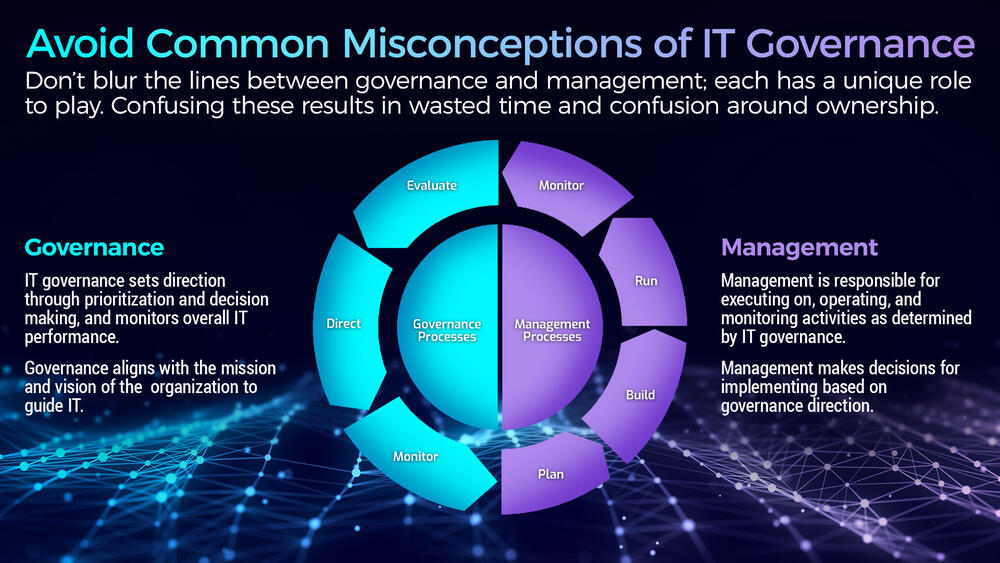
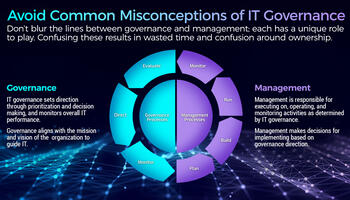 Improve IT Governance to Drive Business Results
Improve IT Governance to Drive Business Results
 Maximize Business Value From IT Through Benefits Realization
Maximize Business Value From IT Through Benefits Realization
 Establish an Effective IT Steering Committee
Establish an Effective IT Steering Committee
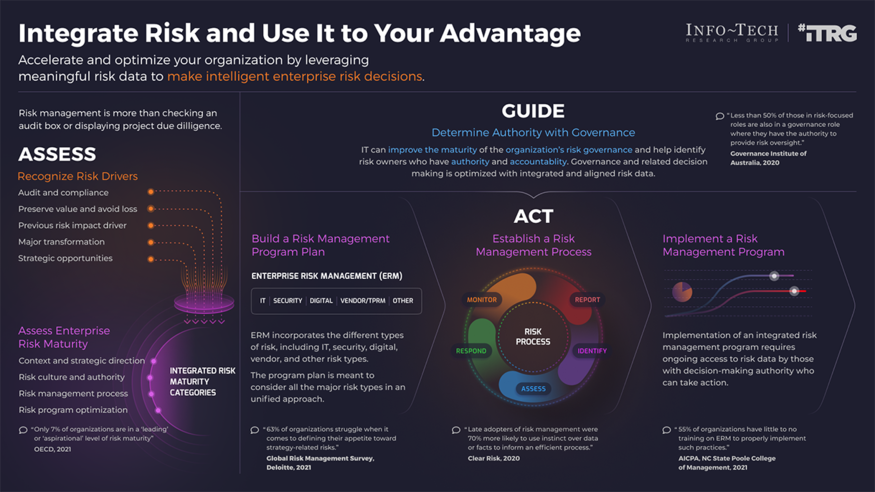 Build an IT Risk Management Program
Build an IT Risk Management Program
 Review and Improve Your IT Policy Library
Review and Improve Your IT Policy Library
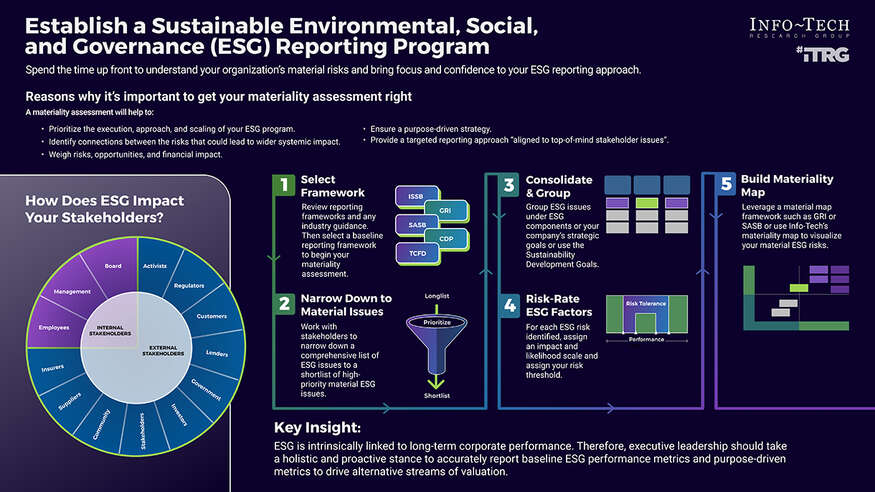 Establish a Sustainable ESG Reporting Program
Establish a Sustainable ESG Reporting Program
 Take Control of Compliance Improvement to Conquer Every Audit
Take Control of Compliance Improvement to Conquer Every Audit
 Establish an Effective System of Internal IT Controls to Mitigate Risks
Establish an Effective System of Internal IT Controls to Mitigate Risks
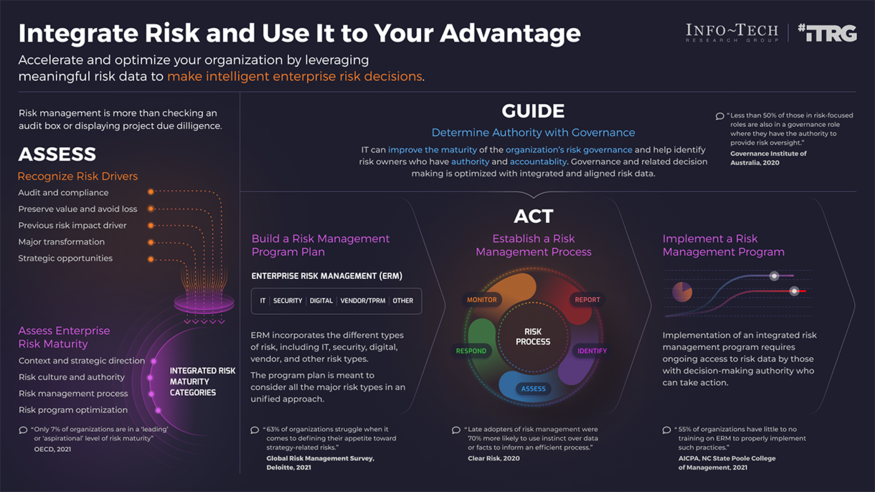 Integrate IT Risk Into Enterprise Risk
Integrate IT Risk Into Enterprise Risk
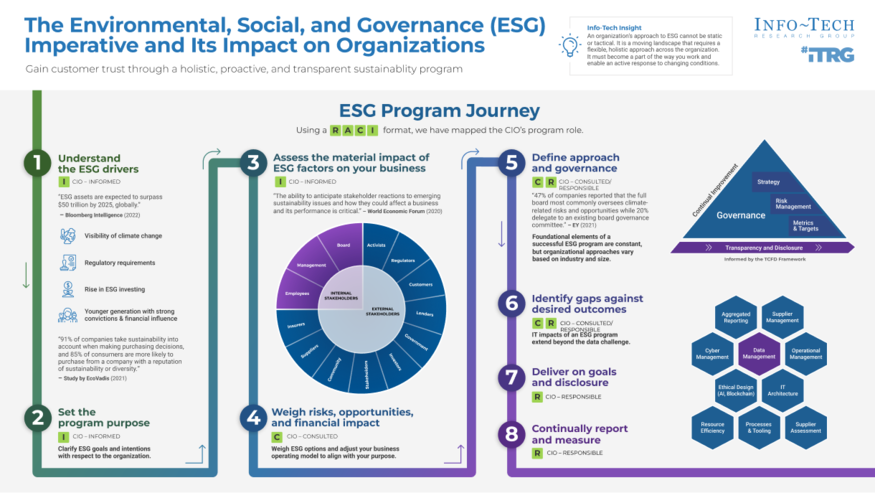 The ESG Imperative and Its Impact on Organizations
The ESG Imperative and Its Impact on Organizations
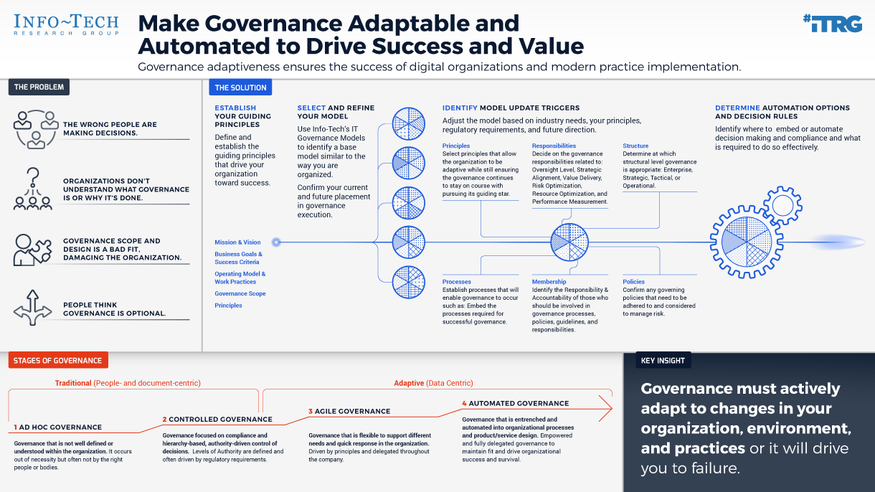 Make Your IT Governance Adaptable
Make Your IT Governance Adaptable
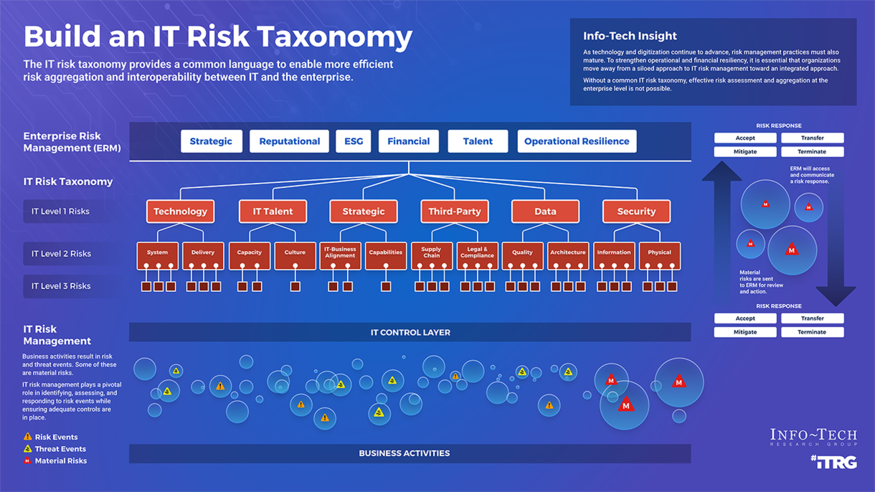 Build an IT Risk Taxonomy
Build an IT Risk Taxonomy